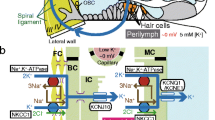Summary
Changes of the cochlear microphonic potentials were studied after replacing the perilymph by various media of different electrolyte composition, containing metabolic inhibitors and with or without energy rich phosphate compound. It was found that the ionic composition of the perilymph was not the only factor affecting the cochlear microphonic potential. Three metabolic inhibitors were used; they were 2–4 dinitrophenol, oligomycin and iodoacetic acid. To restore the microphonic potential, phosphoenolpyruvate was proved to be a useful agent.
Zusammenfassung Das Verhalten der Mikrophonpotentiale nach Austausch der Perilymphe der Scala tympani gegen Medien mit anderer Elektrolytzusammenfassung, mit Stoffwecbselblockern und mit energiereichem Phosphat wird untersucht. Dabei stellt sich heraus, daß die Elektrolytverhältnisse nicht allein ausschlaggebend sind. Durch Blockierung der Atmungskettenphosphorylierung mit DNP, durch Blockierung des ATP-Aufbaues mit Oligomycin und durch Blockierung der anaeroben Energiegewinnung mit Monojodacetat lassen sich die verschiedenen Energielieferanten in ihrer Bedeutung für die Mikrophonpotentiale isoliert austesten.
Phosphoenolpyruvat als membranpermeables energiereiches Substrat ist — nach Perfusion der Scala tympani — geeignet, den ATP-Mangel bei DNP-Vergiftung wieder auszugleichen.
Similar content being viewed by others
References
Bruni, A., Azzone, G. F.: The site of action of atractyloside and oligomycin in the mitochondria) energy-transfer system. Biochim. biophys. Acta (Amst.) 93, 462 (1964).
Caldwell, P. C.: The phosphorus metabolism of squid axon and its relationship to the active transport of sodium. J. Physiol. (Lond.) 152, 545 (1960).
— Hodgkin, A. L., Keynes, R. D., Shaw, T. I.: The effects of injecting “energyrich” phosphate compounds on the active transport of ions in the giant axons of loligo. J. Physiol. (Lond.) 152, 561 (1960).
— Keynes, R. D.: The utilization of phosphate bond energy for sodium extrusion from giant axon. J. Physiol. (Lond.) 137, 12 (1957).
Chou, J. T. Y.: The effect of cardiac glycoside on the microphonic potential. Arch. klin. exp. Ohr, Nas.- u. Kehlk. Heilk. 195, 246 (1970).
Davis, H., Tasaki, I., Smith, C. A., Deatherage, B. H.: Cochlear potentials after intracochlear injection and anoxia. Fed. Proc. 14, 112 (1955).
Fleckenstein, A., Gerlach, E., Janke, J.: Phosphorylierung und aktiver Kationen-Transport. Schweiz. med. Wschr. 86, Beiheft zu Nr. 37, 1041 (1956).
Harary, I., Slater, E. C.: Studies in vitro on single beating heart cells. VIII. The effect of oligomycin dinitrophenol and ouabain on the beating rate. Biochim. biophys. Acta (Amst.) 99, 227 (1965).
Konishi, T., Kelsey, E.: Effect of cyanide on cochlear potentials. Acta oto-laryng. (Stockh.) 65, 381 (1968 a).
— Effect of sodium deficiency on cochlear potentials. J. acoust. Sec. Amer. 43, 462 (1968b).
— Effect of tetrodotoxin and procaine on cochlear potentials. J. acoust. Sec. Amer. 43, 471 (1968 c).
—, Mendelsohn, M.: Effect of ouabain on cochlear potentials and endolymph composition in guinea-pigs. Acta oto-laryng. (Stockh.) 69, 192 (1970).
Krebs, H. A., Kornberg, H. L.: Energy transformation in living matter. Berlin-Göttingen-Heidelberg: Springer 1957.
Kuijpers, W.: Cation transport and chochlear function. Acta oto-laryng. (Stockh.) 67, 200 (1969).
Lardy, H. A., Elvehjem, C. A.: Biological oxidations and reductions. Ann. Rev. Biochem. 14, 1 (1945).
, -Johnson, D., McMurrary, W. C.: Antibiotics as tools for metabolic studies I. A survey of toxic antibiotics in respiratory, phosphorylative and glycolytic system. Arch. Biochem. 78, 587 (1958).
Lehninger, A. L.: Oxidative phosphorylation. Harvey Lect. p. 176–215 (1954).
Lipmann, F.: Metabolic generation and utilization of phosphate bond energy. Advanc. Enzymol. 1, 99 (1941).
Loomis, W. F., Lipmann, F.: Reversible inhibition of the coupling between phosphorylation and oxidation. J. biol. Chem. 173, 802 (1948).
— Inhibition of phosphorylation by azide in kidney homogenates. J. biol. Chem. 179, 503 (1949).
Matschinsky, F. M.: Chemical analysis of microscopic structures of the cochlear duct. Z. Hörgeräte Akust., J. Audiol. Techn. 26.-31. October 1970.
— Thalmann, R.: Quantitative histochemistry of microscopic structure of the chochlea. Ann. Otol. (St. Louis) 76, 639 (1967).
Prankerd, T. A. J.: Chemical changes in stored blood with observations on the effect of adenosine. Biochem. J. 64, 209 (1956).
Rossum, G. D. V. van: The effect of oligomycin on net movements of sodium and potassium in mammalian cells in vitro. Biochim. biophys. Acta (Amst.) 82, 556 (1964).
Serydarian, M. W., Sato, Ed., Savageau, M., Harary, L: In vitro studies of beating heart cells in culture. XII. The utilization of ATP and phosphocreatine in oligomycin and 2-deoxyglucose inhibited cells. Biochim. biophys. Acta (Amst.) 180, 264 (1969).
Simon, E. W.: Mechanisms of dinitrophenol toxicity. Biol. Rev. 28, 453 (1953).
Slater, E. C.: Metabolic inhibitors: A comprehensive treatise, Chapt. 32. p. 503. edit. by R. M. Hochster and J. H. Quastel: New York: Academic Press 1963.
Tasaki, I.: Hearing, Ann. Rev. Physiol. 19, 417 (1957).
— Fernandez, C.: Modification of cochlear microphonics and action potentials by KCl solution and by direct currents. J. Neurophysiol. 15, 497 (1952).
Vosteen, K. H.: Neue Aspekte zur Biologie und Pathologie des Innenohres. Arch. Ohr.-, Nas.- u. Kehlk. Heilk. 178, 1 (1961).
— Elektronenmikroskopische Untersuchungen über die Verteilung von Glykogen im Ductus chochlearis beim Meerschweinchen. Pract. oto-rhino-laryng. (Basel) 26, 400 (1964).
Whittam, R.: Potassium movements and ATP in human red cells. J. Physiol. (Lond.) 140, 479 (1958).
Author information
Authors and Affiliations
Rights and permissions
About this article
Cite this article
Chou, J.T.Y., Vosteen, K.H. The effect of ionic concentration, metabolic inhibitors and high energy phosphate compound on the microphonic potential. Arch. Klin. Exp. Ohr.-, Nas.- U. Kehlk. Heilk. 200, 300–317 (1971). https://doi.org/10.1007/BF00373312
Received:
Issue Date:
DOI: https://doi.org/10.1007/BF00373312




